
Photo: Philemon in love with a eucalyptus tree
| Greetings Home |
| Previous Greeting |
Crtd 06-12-27 Lastedit 15-10-27
Dhow Repairs
In love with a tree
 Photo: Philemon in love with a eucalyptus tree |
On the last lap to Banda we had heard a crack in the top part of the mast. Nothing to see, but it clearly started bending more than usual. Internal crack? We mounted an additional stay for additional mast support. On lowering the sail a ring in the winch broke. The cog-wheels disjoined. I repaired it it provisionally. The mast, we concluded, had to be replaced before returning to Jinja: we had to sail to the Sese town Kalangala, to find the right size of eucalyptus stem somewhere, probably Entebbe, take it by ferry to Kalangala, and mount it somehow (mounting is not easy, see mounting the mast). We had three options:
use Dominic's castle roof to fix wires,
mount the new mast with the old, then dismount the old mast with
the new, oruse the crane of the Kalangala ferry, operated by Tanzanians.
We hoped that seeing Philemon, Doi and a Tanzanian dhow might
bring them in a helpful moodFirst enquiries hinted at Entebbe for the proper eucalyptus mast tree. After arrival at Loek Verburg's Kalangala Hornbill Camp we spread the news for what kind of tree we were looking. Half a day later Johan, a semi permanent Dutch camp dweller reported trees of the sought type on an hour's walk up hill. Philemon and I climbed up, and found a soccer field size plot of eucalyptus, and our tree was among them (on the picture left Philemon is already in love). Under normal circumstances the tree would be worth under USh 10 000/= (� 4.50)
The next job was to find the owner of the site, carefully hiding the fact that the aspirant buyer's skin is white. Despite that we obtained reports that the tree planter was not the land owner, and the forestry officials would have a say.
[to continue: scroll down]
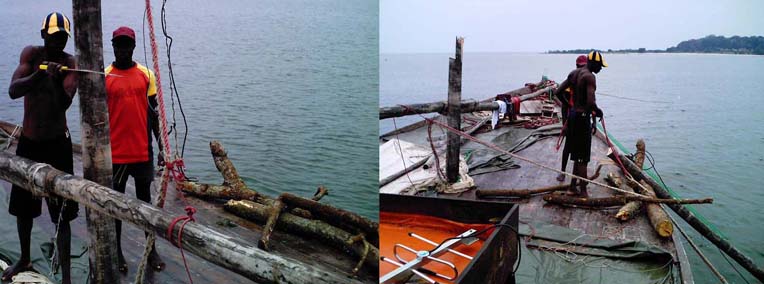
Photo: Cutting the mast. Note, on the right side on deck, the camp's firewood borrowed to break the fall on the board edge
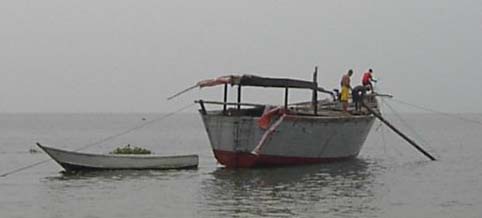
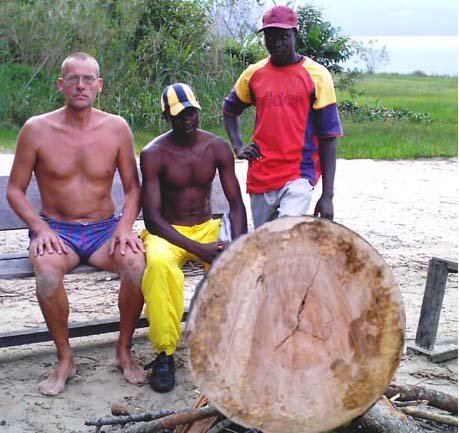
Photo: burning our mast, note the three cracks going out from the centre
Two days later we had cut our old mast.
On its suspicious place it featured an internal crack from the centre in three
directions. Our tree owner inquiries had not made a lot of progress, and I
decided to head for the Kampala shopping for new stays, a stay tightening system
with pulleys and some other hardware meant to make the life of the next mast a
bit longer that the sad 9 month record of the old one.
Shopping in Kampala on I got haunted again by an
atrium fibrillation (heart rhythm
irregularity). Stepping up beta-blocker and waiting on the hotel bed, reading
books and watching the occasional BBC TV endlessly repeating the pictures of the hanging
of the only man capable and willing to rule Iraq, Saddam Hussein, was the obvious first option, since doctors also celebrate the year
change. On day 3 of the fibrillation, January 2, at International Hospital
Kampala it was decided that they had no viable alternative to what I was doing
already, since flecainide, the appropriate drug for an instantaneous redress by drip
treatment, was neither available nor
thought to be obtainable. They have a defibrillator (a machine that stops the heart by an
electric pulse, after which it should start beating regularly), but they apparently
feared to apply it to me. Back in my hotel I decided, as I have to do every
other week, that this is Africa, and thus needs different thinking. I decided to counter the obviously
bad mood by a restaurant visit, some good food and - in defiance of my
ongoing zero-alcohol test to counter depression tendencies - a beer. Right after the beer,
the heart went regular. Does Ugandan beer contain flecainide? But yes, dear
reader, let me be honest: jokes only come afterwards. A-fib can become chronic
and then you will climb stairs like a ninety year old the rest of your life,
which may be long, you do not easily die of it. Whatever, better ill here
between stone age hominids equipped with some written off Western tools they are
incapable to handle, than living anywhere
in the vicinity of a state of the art Dutch hospital.
Back to Kalangala, the island! Everybody was pleased to see me back in good health. Since nobody there is interested in
who hangs whom, I did not even bother to bring the news of Saddam, and started to
realize that in Kampala not the heavy noise, dense dust and filthy dirt, but
indeed TV is the really serious and poisonous inconvenience.
One day later I was endowed with a GENERAL RECEIPT of the National Forestry
Authority for a license to cut one (1) eucalyptus tree. Price: USh 10 000/= (� 4.50),
the Kampala hardware for mounting the mast (steel wire, U-shackles, eyes) had
cost me over fifty times as much.
After our tree had fallen, I counted 11 steps instead of
12. My heart stood still. Cut another tree? Philemon measured feet with his feet
and was "only one foot short". A foot or a meter short??? But
Philemon claimed that
9 months ago, he had not cut our old mast at 12 meters, as I had told him to do,
but at 37 foot (11.38 m). So my heart could start beating again, the tree was
probably OK. Loek Verburg's Hornbill Camp Landrover of towed it over 3 km, 300 m down to
the camp beach.
Luckily enough the Kalangala ferry is operated by Tanzanians, glad to see a
Tanzanian dhow and to help us lifting the mast in with their crane. Philemon was
our high profile intermediary there, I was "just a muzungu traveling with the
dhow" to avoid being ruthlessly overcharged for the service. Three of the ferry
crew even are Mgita, Philemon's tribe, ready to help free of charge, but they
did not attend the operation where the ship's engineer, from Kilwa, South Coast
Tanzania, asked Ush 50 000 and got Ush 30 000 (euro 13.50, a fortune). I advised
Philemon to inform his Mgita tribesmen on the ferry, to avoid making the
impression he had conspired with the Kilwa engineer. That was easy enough,
because he had disappeared on the island with the money.
Whatever the length of the old mast, the marks on our winch wire proved that the
new mast was half a meter too short. This means that the highest top of the
folmali is about 18 meters above the deck (20.5 above the lake!), a meter too low. Not enough to warrant cutting the sail.

Photo: Loek Verburg's Hornbill Camp Landrover towed our mast down to the shore
Meanwhile I had managed to to repair our halyard winch with some parts that had appeared out of a Kampala hardware dealer's can with old rings. But then our inverter (making 230 V AC from our 12 V battery) ended service with a bang and a nice amount of smoke. An unhappy course of leaking rain water in the night had created an internal shortcut. Total loss. The new one will cost the same as the entire new rigging, � 150/=, it may seem little to you, but here it is fifteen meals in the best restaurants around, and for an average Ugandan: half an annual wage. I decided I was too happy on the island to pay another visit to Kampala. We would rely on the occasional running of the generator. No fridge. The test with with zero beer would be extended over January, and to test effect on heart rhythm, zero cigars as well. Whatever the result: a cold beer and a Havana on February 1!
In the night we started to hear sounds as if we were buried and cows were grazing at our graves. On inspection, these turned out to be tilapia fish energetically tearing the fouling (lake weed) from our hull outside. We saw literally thousands of them. They attracted, in turn, night fishermen eagerly preying less then half a meter from our boat. We had to chase them. Finally, the tilapia stayed even at day time and a fish eagle decided to use the top of our new mast for his raids.
Photo: fish eagle quite pleased with our the new mast
Back to Jinja.
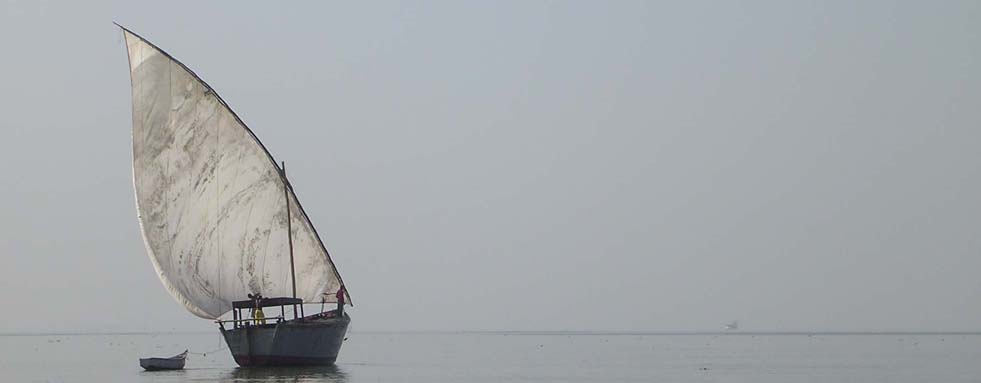
Photo: Back to Jinja. New mast: 11.5 m total, 9 m above the deck. Folmali 25 m. The Kalangala ferry, who had helped us mounting our mast with their crane, arriving far right.
With Dominic as our guest, we hoisted, found our new mast just long enough to closely haul the folmali (on the picture you see the front tip of the folmali just reaching the deck at the bow), and sailed to Jinja in the unbelievable time of two days, 70 km each day. Normal is 4 days, 6 days is not unusual. At comfortable speeds of 9 to14 km/hrs the islands and coastlines glided by. Back in Jinja my car did work as normal, UTL internet service was down as usual, Philemon had a typhoid and Doi about a square meter of early stage psoriasis. So now everybody is on drugs. I have only slight depression symptoms and a small heart irregularity every now and then (no fibrillation), I'm off beer and cigars until February 1, and smearing a cream all over Doi every day, that's all. After swimming five times a day in the lake for almost a year I took bilharzia pills for safety. The test is more expensive and not 100%. So many, like me, just take the pills every now and then. If the pills do not make you sick you do not have it. They did not.
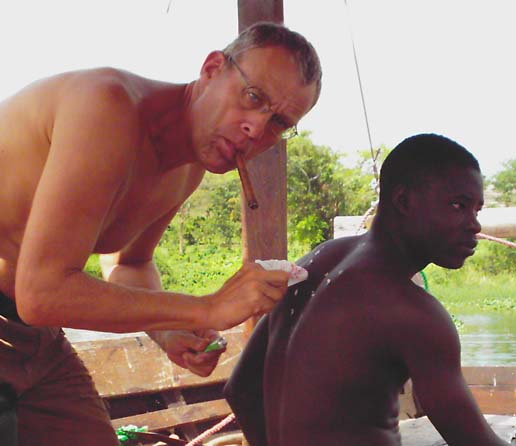
Photo : betamethasone dipropionate en salicylic acid
that'll teach them!
(taken februari 7, zero booze regime extended, cigars down to VERY special
occasions - occasion this time: excellent mood)
| Greetings Home |
| Previous Greeting |